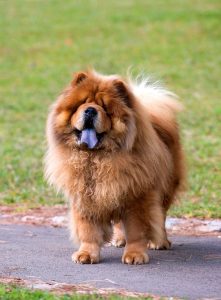Chow Chows are a unique and fascinating breed of dog known for their distinctive appearance and, most notably, their blue-black tongues. This physical characteristic often sparks curiosity and questions among dog lovers. In this comprehensive article, we will delve into the intriguing question of why Chow Chows have blue tongues, exploring the genetic and biological factors that contribute to this fascinating trait.
Understanding the Genetic Basis: To understand why Chow Chows have blue tongues, we need to explore the genetic factors at play. The blue-black coloration of their tongues is due to the presence of pigmentation caused by a gene known as the TYRP1 gene. This gene regulates the production of pigment called melanin, responsible for the coloration of various tissues in the body, including the tongue.
A Unique Trait Among Dog Breeds:
Interestingly, the presence of blue tongues is not limited to Chow Chows alone. Other breeds, such as the Shar-Pei, also exhibit this trait. This suggests that the genetic mutation responsible for the blue tongue trait is shared among these breeds. While the exact origin of this mutation is still a subject of study and speculation, it is believed to have occurred in ancient times.
The Role of Melanin:
Melanin plays a crucial role in pigmentation throughout the body. In most dog breeds, the tongue appears pink or black due to the presence or absence of melanin. However, in Chow Chows, the melanin production extends to the tongue, resulting in a distinct blue-black coloration. It’s essential to note that this pigmentation does not have any detrimental effects on a dog’s health or well-being.
Ancient Origins and Cultural Significance:
The blue tongue trait in Chow Chows is believed to have ancient origins, dating back thousands of years. Some theories suggest that this genetic mutation may have been intentionally bred for, as it was considered a desirable and unique characteristic in ancient China. In Chinese culture, the color blue is associated with good luck and protection against evil spirits, further enhancing the cultural significance of this trait.
Biological Advantage:
While the blue tongue trait in Chow Chows may be visually striking, it also serves a practical purpose. The high concentration of melanin in their tongues provides protection against sunburn and potential damage from harmful ultraviolet (UV) radiation. This adaptation is particularly important in dogs that live in regions with intense sunlight exposure, such as the northern parts of China where Chow Chows originated.
 Other Factors to Consider:
Other Factors to Consider:
It’s important to note that the blue tongue trait is not the sole distinguishing characteristic of Chow Chows. They are also known for their dense double coat, lion-like appearance, and independent nature. Chow Chows are a ancient breed with a rich history, and their blue tongues are just one fascinating aspect of their overall makeup.
Conclusion:
The blue tongues of Chow Chows are a captivating and unique trait that sets them apart from other dog breeds. Through genetic factors, specifically the presence of the TYRP1 gene and melanin production, Chow Chows exhibit this striking coloration in their tongues. This characteristic not only adds to their visual appeal but also serves a biological purpose by providing protection against UV radiation. As we continue to learn more about the genetic makeup and history of Chow Chows, their blue tongues remain a distinguishing feature of this remarkable breed.

